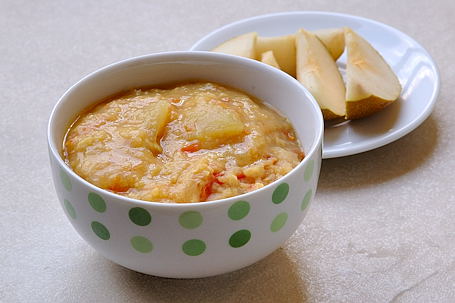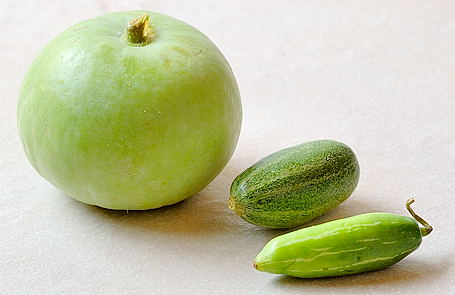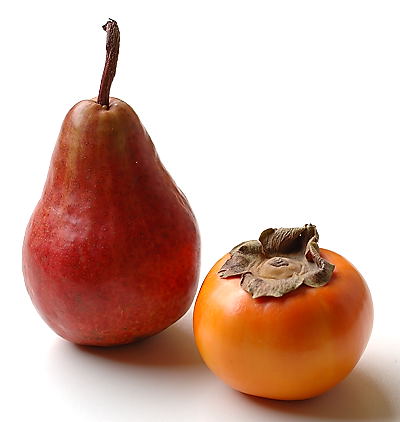
Red Bartlett Pear and Persimmon


Cool Treats:
Gulab Jamun Cake ~ from Recipes N More
Jowar Vada (Jonna Garelu) ~ from Nourishing Indian Food
Mango Lassi Frozen Yogurt ~ from Evil Jungle Prince
Potatoes Mashed in Coconut Milk ~ from Tofu for Two
Saffron Rava Badam Cake ~ from Red Chillies
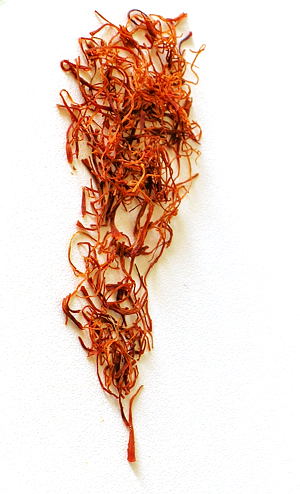
The majestic Saffron is one spice that rightfully deserves our respect. The number of hours spent plucking the saffron flowers and then the stigmas is just mind blowing. Something like 50,000 flowers, a football field-sized patch, must be grown to produce just one pound of saffron.
Saffron is the stigma of crocus flower, so the botanical name Crocus sativus. Harvest season lasts for 2 weeks and the flowers are picked each morning. The 3 stigmas in each blossom are hand-picked. After plucking, the stigmas are light roasted which dries the stigmas and fixes the flavor in the threads. This delicate stage of roasting is done only by the most expert of farmers. Even as little as a minute too long on the fire and the whole batch would be ruined.
The saffron crocus is sterile and the crop is propagated by corm multiplication. Each corm lasts only for one season and then is replaced by up to 10 cormlets. The size of the corm has a very significant effect on the production of daughter corms, and on the production of flowers and the yield of saffron. Saffron flower is amazingly beautiful and fragrant. It has pale lilac petals with dark colored veins. Saffron crop can tolerate frosts and an occasional snow. It grows in a wide range of soils but thrives in clay-calcareous soil.
Saffron is used in Ayurveda as a good heart tonic for all three doshas, and is also an important ingredient in many Ayurvedic medicines. For example, “Shatavari Plus” has saffron as one of its main ingredients. Saffron has circulatory stimulant properties, is warming and very rejuvenating. Saffron milk is an excellent remedy for Anemia. It is also known to tonify the female reproductive system. The cosmetics industry uses saffron in lotions and creams for its ability to nourish and lighten the skin.
And, of course, we all are familiar with the bright golden yellow Saffron robes of Buddhist monks. The color of their robes speaks volumes of their renunciation. When a young green leaf turns yellow or orange, it falls off from the tree. The Buddhist monks wear yellow saffron robes to constantly remind them to let go and not cling to the earthly pleasures.
Since Saffron and Kashmir are inseparable and I am such a big tea fan, we have to have a cup of Kahva (Kashmiri chai with saffron). This tea is amazingly aromatic and an experience in itself. Here is a very good post on Kahva. Note that this Kahva is different from Kava, a herbal drink from south Pacific.
A classic and simple dessert with Saffron is Shrikhand.
Classic Shrikhand with Saffron:
1-cup whole milk yogurt
1-cup sugar
Saffron – 1 teaspoon, or to your liking
Charoli (chironji) – 1 tablespoon, or to taste
Crushed cardamom seeds – ¼ teaspoon
Tie yogurt in a clean muslin cloth. Keep in a sieve and place a heavy pan over it. Keep overnight to drain all water. Once all water is drained from the yogurt, add sugar and mix really well. Sugar must be dissolved completely. Add crushed cardamom, saffron. Serve with charoli on top.
Some of you might remember that I mentioned once about growing mustard seeds and enjoying the beauty of Punjab in my own backyard. Now, how about a little Kashmir in your back yard. We can grow our own Saffron!. Looks like some avid gardeners are even growing Saffron in containers. There are a lot of online vendors and nurseries where you can buy the saffron corms. Growing Saffron is time consuming and needs a lot of patience. But I think I am up for this project too.
Now let’s see… I have mustard from Punjab, Saffron from Kashmir… Hmm … what’s next?
by ~ Anjali Damerla of Supreme Spice
Notes:
For a fabulous array of saffron recipes: Think Saffron

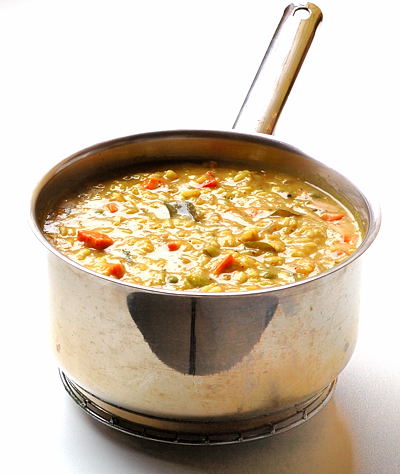
They see each other everyday.
Unassuming and simple, darling daughter of lentil family – the golden Toor Dal.
The upright, some even call almighty – the proud and pristine Rice.
A hill of rice on a banana leaf, and a ladle full of dal next to it. Served and seated next to each other, the attraction between them was instantaneous and electric. It hasn’t escaped the wise hostess notice. The marriage was inevitable. Nourishing vegetables and sensual spices were added for a seductive liveliness. Under the sacred fire, they seized to be toor dal and rice, instead became Bisi Bele Huli Anna. “A match made in heaven, for good times and for hard times”, people praised the joyful union.
Bisi bele huli anna. Yes, all would be all right!
That was the “once upon a time” story for Bisi Bele Huli Anna, the famous south-Indian comfort food. Originated in Karnataka region of India, the rustic and rural Bisi bele huli anna with its uncomplicated, unfettered and fundamental recipe has many fans. From children to very elderly, many Bharatiya find delight in this humble food.
This week’s cold snap made Bisi bele hule anna a prudent choice for us. And, I remembered I had a jarful of Rosematta rice. The plump, terracotta colored rice from Kerala region absorbs flavors very well and I know that toor dal will be swooning in Rosematta company. My preparation started with fresh Bisi bele ground masala and cutting up the vegetables. We can add any number of vegetables and I went with gawar beans, red bell pepper, red onions, peas and carrots. The Bisi bele huli anna turned out to be a delightful meal. Long live Bisi Bele Huli Anna!
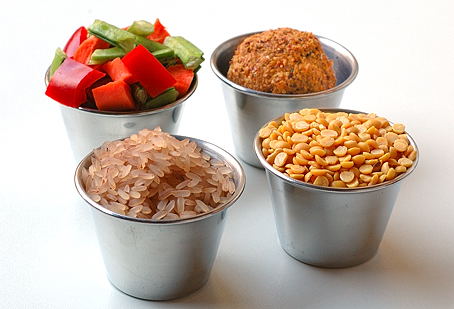
Recipe:
1 cup Rosematta rice
1 cup toor dal (Kandi Pappu)
3 cups cut vegetables (beans, carrots, peas and peppers etc)
2 tablespoons tamarind pulp
1 tablespoon jaggery
½ teaspoon each – turmeric and salt
2 tablespoons – Bisi bele masala (Homemade or store-bought)
Popu or tadka ingredients:
(12 Curry leaves, pinch each- cumin, mustard seeds and hing)
Take rice and toor dal in a wide pot. Add about 6 cups of water. Cook the dal and rice to very tender. Gently mix and mush them. I resorted to pressure-cooking, but back at home, they cook it for an hour or so on slow heat. Results in superb taste.
While the rice and dal are cooking, in another big vessel, heat a tablespoon ghee or oil. Add and toast the tadka ingredients (curry leaves, cumin, mustard seeds and hing).
To the tadka, add the cut vegetables and saute. When they start to get tender, add the tamarind pulp, jaggery, turmeric and salt. Also the cooked and mashed rosematta rice-toor dal mixture. Stir in the masala along with two cups of water. Combine well. Have a taste and adjust the spices to your liking. Cover the pot and simmer for about ten to fifteen minutes on medium-low heat.
Serve hot with a teaspoon of ghee drizzled and with papads.
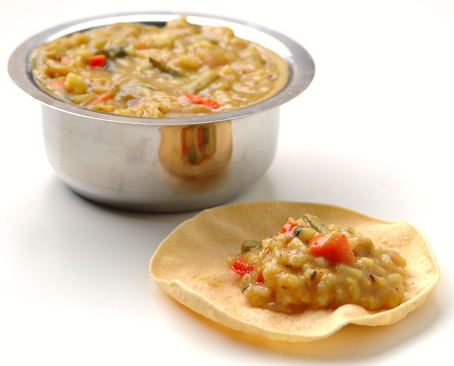
Recipe Notes:
Rosematta idea from My Chow Chow Bhath. Brown rice or brown basmati also works well for this recipe.
My recipe for Bisi bele masala:
5 dried red chillies, 1 tablespoon each- chana dal & coriander seeds, 1 teaspoon cumin, ¼ teaspoon each -cloves, cinnamon, methi seeds and black peppercorn. Dry roast. Cool. Then take them in a Sumeet Mixer or blender. Add 2 tablespoons of freshly grated coconut and pinch of salt. Grind to fine consistency.
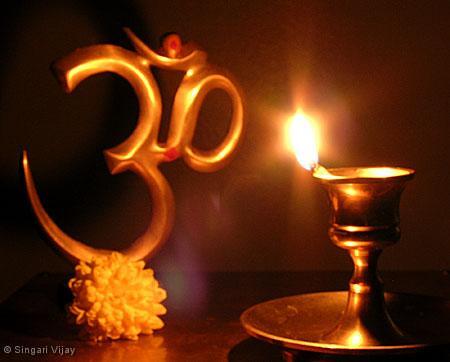
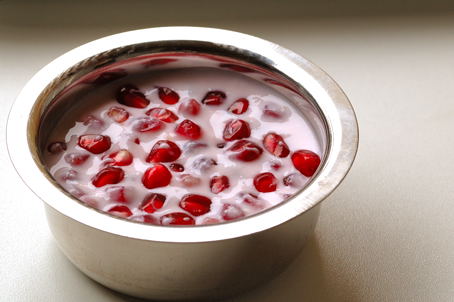
I love fruit-flavored yogurts. I often make them at home with whatever fruit I have at hand. I cut and crush the fruit and mix with homemade yogurt. Depending on the fruit sweetness level, I usually add sugar or honey and salt to the yogurt. Takes only few minutes to prepare and offers a very cool way to end the meal. Also, no matter what time of day it is, a small cup of fruit-yogurt always has the power to cheer me up.
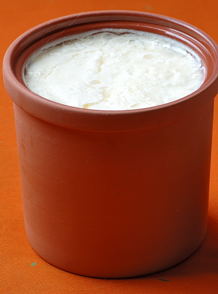
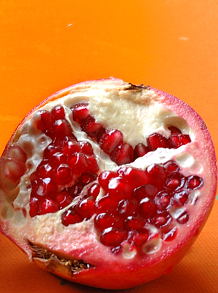
Plump pomegranates and tart cranberries are in season right now here in Seattle. I purchased few pounds last weekend with the idea of preparing jam/cooked relish. I thought it would be fun to try something new with these two tart and fruity ingredients.
I’ve combined the cranberries with pomegranate juice and water. The sweetener was the jaggery. I let them simmer on medium heat to jam like thick consistency. It was an easy process.
I made pecan pancakes for lunch. The carbos and the bright tasting jam, I really liked the whole combination. People who go for unique flavors and anti-oxidant fanatics alike will enjoy this jam/relish, I think.
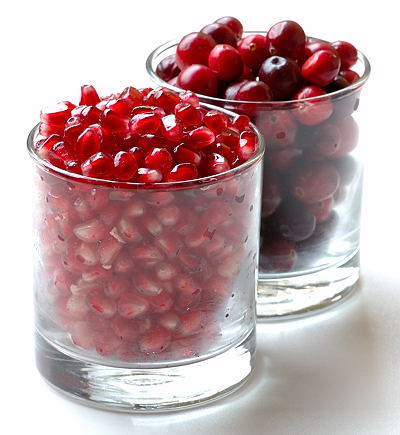
Recipe:
2 cups pomegranate seeds
2 cups cranberries, rinsed
2 cups jaggery, crushed
1 cup water
Coarsely crush pomegranate seeds (blender, citrus juicer, food mill or with your hands). Pour through a coffee filter to remove the seeds and extract the juice. (I carried this process somewhat carelessly, thinking few escaped seeds won’t hurt, but I will be taking extra precautions next time to remove seeds completely.)
Take pomegranate juice, cranberries and jaggery in a wide pot. Add water. Bring to a boil. Then simmer, uncovered for about 15 to 20 minutes, till the cranberries pop and the whole thing thickens to jam like consistency. Let cool and store in a clean jar.
Enjoy with pancakes, or as bread/ chapati spread.
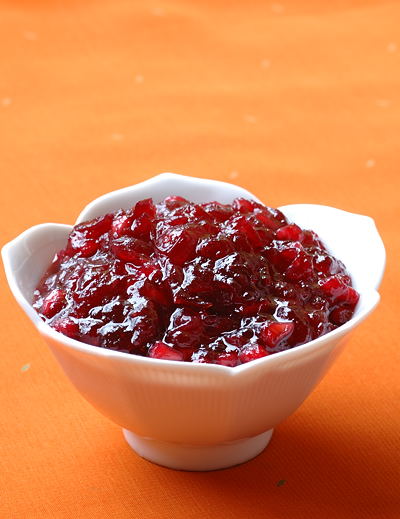
Last week I watched a documentary on pumpkins called “Lords of the Gourd,” on PBS. The effort that goes into the giant pumpkin production was really amazing to see. Pumpkins were bathed in milk for prize winning looks, fed on bathtub sized fertilizer solutions, and grown to a groan-inducing size of 800, 1,200, 1,500 pounds – it’s pumpkin passion, godzilla style. The documentary covered many aspects of this competition craziness, but they forgot to mention how these giant pumpkins taste. It doesn’t matter I guess.
If I ever participate in such competition, my pumpkin would be nourished on food blogs feed.:) Thousands of food blogs and all those mouthwatering recipes, the baby pumpkin would have no choice but turn in to a big balloon. Here is the rough sketch of how-to setup. The overfed champion would not only be big, but I am confident that it would also win in taste department. If not, I can always rely on my prized pumpkin recipe “Matar-Kadoo ki Dalâ€Â, the kind of dish that will thrill the taste buds and delight the eyes.
“Matar-Kadoo ki Dal” is a traditional Indian recipe, with green split peas and pumpkin. Typical Indian masala seasoning, and for special spicy touch, wadis (sundried dal-spice rounds) and peppercorn are added. Perfect for cool weather, but watch out for those intracranial explosions.:)

Recipe:
(for two, for two meals)
2 cups green split peas
2 cups pumpkin, peeled and cubed. (I used acorn squash)
½ cup wadis (available at Indan grocery)
1 big red onion, finely chopped, about a cup
1 teaspoon, ginger-garlic-cilantro paste
1 teaspoon goda masala powder (or garam masala)
¼ teaspoon black peppercorns- coarsely crushed
Salt and turmeric to taste
For tadka or popu:
2 tablespoons peanut oil,
Pinch each, cumin and mustard seeds
8-10 curry leaves
Take green split peas in a vessel. Cover with water and simmer to tender (but not too soft).
While the split peas are cooking, in another big pot, heat peanut oil. Add and pan-fry the wadis to crisp. Remove them to a plate and set aside.
In the same pot, to the heated oil, add and toast cumin, mustard seeds and curry leaves. Next goes the onion and ggc paste. Cook until onions are soft. Add the cubed pumpkin, and saute for about five minutes.
Stir in the cooked green split peas along with the water they simmered in. Also, add the goda masala powder, peppercorns, salt and turmeric. If the dal looks too dry, dilute it with water, about a cup. Mix, cover, and simmer for about 10 to 15 minutes, till the pumpkins reach the softness you desire. (Both pumpkin and green split peas cook to soft in short time.)
Sprinkle the crisp wadis and serve with rice or roti. It tasted great on its own also.

From Hindi to English: Matar = Peas, Kadoo = Pumpkin
Recipe adapted from “The Spice Box by Manju Shivraj Singh”
by Janani Srinivasan
Students and Rasikas of Karnatic classical music who fondly (or not 🙂 ) recall their first tentative forays into “Sarali” and “Janta Varisais” might also remember that the credit for a creating a pedagogy of Karnatic classical music goes to Sri. Purandaradasa. And if your mother was a particularly determined woman, you may even have dutifully trotted out works from his corpus to bored admiring relatives come socio-religious occasions like Navarathri and Varamahalakshmi Vratha gatherings.
Whether it is Ratnakara the bandit turned into the Adikavi Sri.Valmiki Muni, or Angulimala the grisly finger-slicing highway terrorist turned Buddhist monk, tales of what can fairly be called instantaneous and extreme spiritual makeovers have captured the imaginations of generations of Indian story tellers and their listeners for centuries. The narrative arc usually progresses along the lines of hopelessly-and-diabolically-evil-person reaches the apogee of his (supported usually by a silently long-suffering her) evilness when a chance encounter; usually in the form of divine grace; completely awakens and transforms said individual. They then attain a sort of mythic stature and are held up as role models for future generations to emulate. Indeed, the story of the rapaciously greedy miser-turned musician-mystic Sri Purandaradasa is a familiar and inspiring one to many of us who grew up listening to these tales. Wiki weighs in with a more complete history of Sri Purandaradasa.
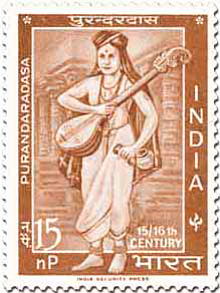
In our family, one of our all-time personal favourites from his oeuvre remains the haunting “Ragi Tandira”. Kannada speakers will identify with the clever punning on the word “Ragi”. Much like a Zen koan, the lyrics here have layers of meaning couched in seemingly quotidian references.
Indeed it is not hard to surmise that Purandhara dasa, once he became a wandering minstrel after giving up his former materialistic life, must have still been intimately familiar with the kind of people that once made up his close family and friends circle. Hence, his desire to show them the path to a more richer inner life must have been tempered with the practical consideration that they might reject his message if he was too heavy handed or preachy.
This composition opens with the poet singing, “Have you brought Ragi for alms?” He then goes on to describe Ragi in glowing adjectives “Yogyaragi , Bhogyaragi” and so on… While in one sense, it can be read as an extolling of Ragi, the staple local grain, the sustainer of life itself with various adjectives: Yogya (worthy) + Ragi, Bhogya (enjoyable) + Ragi ; on another level, it is a veiled injunction to the householders themselves to become “worthy”, “Yogyaragi” as one word.
Here the notion of “Yogyatha” like many words in the vernacular, defies simplistic translation. It is a conflation of many shades of meaning conveying a sense of worthiness, deservingness, etc. The rest of the song progress in the same vein exhorting us to various acts of goodness like offering food to the needy (anna chatrava nittavarAgi), attaining fame for the right reasons (kyathiyali migilAdavarAgi) and cautioning us to stay away from inethical practices (anya varthegaLa bittavarAgi) and so on.
So as homage to Sri Purandharadasa, his beloved Vittala and the ancient grain sustaining generations of his people; here is my mother’s recipe for Ragi Idlis. What a song and dance over a simple grain you say? Well, just try these. Like a mother’s love, these are earthy and wholesome. In a word, Perfect!
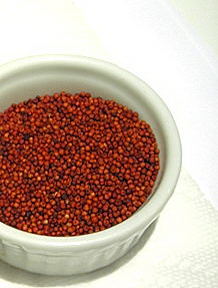
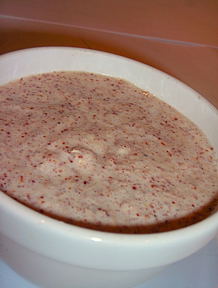
Recipe:
(Makes atleast 2 dozen of the standard sized Idlis- but quantity yielded depends on the Idli mould size.)
Whole Ragi Grain- 1 cup
(I sprouted these for added nutritional benefits. But it’s not strictly necessary)
Idli rice (parboiled) – 1 cup
Whole skinned Urad dal – ¾ cup
Methi seeds -1 tablespoon
Salt to taste
Sesame oil- to grease idli moulds (I used “Idhayam” brand)
After multiple washes, soak the Ragi for a day. Drain and let it rest for another day till you see tiny white sprouts. Alternatively, you can skip the sprouting and just soak the ragi for 3-4 hours longer than you soak the rice. Soak rice, whole urad and methi seeds in separate containers for 4-6 hours or overnight.
In a wet grinder or a mixie /blender, grind the urad dal till light and fluffy. A test for fluffiness is to keep a bowl of water and drop a tiny pinch of batter. If it floats, it is light enough. Then add and grind the Ragi grains and Methi and finally the rice. Take care that the rice should not be ground too smooth. It should be of rice Rava consistency. Alternatively, you can use rice Rava instead. Take the batter in a vessel, fold in some salt to taste and leave it overnight to ferment. I found that the dough fermented really well, doubling up and overflowing the vessel. So take adequate precautions.
Next morning, lightly stir the well fermented batter. Grease Idli moulds and steam in a pressure cooker for 12-15 minutes till done. Ragi idlis can be served with a dollop of butter or ghee on top, along with the usual fixings on the side: sambar, coconut chutney and/or Milagai Podi.
~ Article by Janani Srinivasan
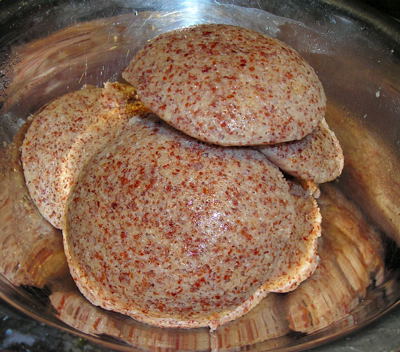
Notes:
Audio of Ragi Tandira sung by the late Sri. Maharajapuram Santhanam in Raga Kalyanavasantham – Link.
Ragi pronounced with “Ra†as “raaâ€Â, “G†as in God not as in gentle, “i†pronounced “eeâ€Â.
Tandira pronounced Thundheera with the “h†NOT aspirated. “T†and “d†sounds softened not sharp as in the common American/English usage and the “an†is pronounced “unâ€Â.
Janani Srinivasan’s articles on Mahanandi: It’s Chakalaka, Baby!, The Arisiupma Trilogy.
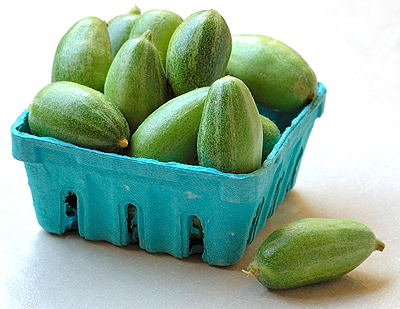
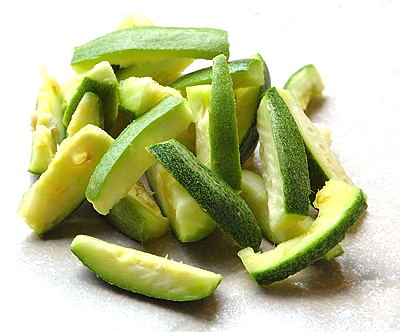
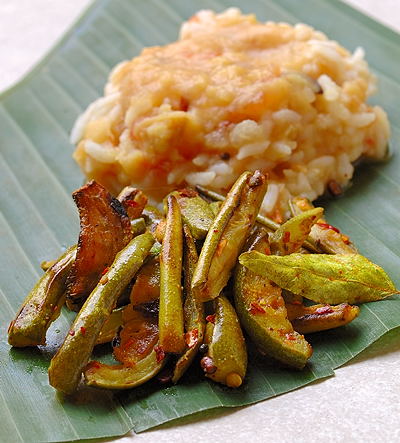
Parval is a beautiful looking vegetable, popular throughout north-India and little seen elsewhere. They are used especially in curry and stews. It has a satisfying soul which makes a filling curry that lifts the spirit. They are little bit hard to find in the United States even at Indian grocery shops, but they are well worth the hunt!
Recipe:
15 to 20 fresh parvals
1 tablespoon peanut oil
10 fresh curry leaves
5 garlic cloves, peeled and thinly sliced lengthwise
Pinch each- cumin and mustard seeds
¼ teaspoon turmeric
½ teaspoon red chilli flakes and salt, or to taste
Rinse parvals under water. Dry them with a kitchen or paper towel. Make a vertical cut in the middle. Then slice each half again into four thin pieces lengthwise.
In a wide skillet, heat peanut oil. Add and toast garlic and curry leaves to pale gold. Next goes the cumin and mustard seeds. When mustard seeds start to pop, add the parval pieces. Mix and cover the skillet. Cook on medium heat for about five to ten minutes. Covering the skillet creates steamy environment that helps to soften the parval. When they start to get tender, remove the lid. Sprinkle turmeric, red chilli flakes and salt. Toss gently and cook for another five minutes, until the parval turn to crisp like shown in the photo above.
Serve right away. Enjoy with rice and dal, or with chapati or dal.
The mere mention of chole, the famous Punjabi recipe with chickpeas, elicits feelings of comfort and good eats. Bring in the Punjabi tinda, the chole becomes extra special.
The food I prepared today inspired by two Punjabi specialties “chole with Punjabi tinda” turned out to be excellent. Along with Punjabi tinda, I also added tomatoes and potatoes to chickpea chole. Few teaspoons of kasuri methi livened up the chole with wonderful aroma.
A harmonious, energizing and filling meal!
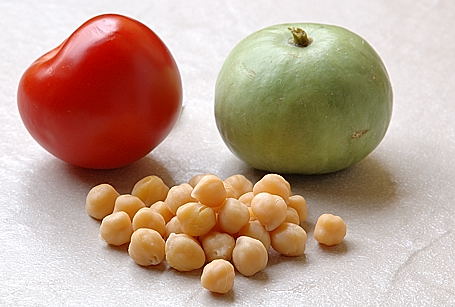
Recipe:
(for two, for two meals)
1 tablespoon – ghee
1 onion- finely chopped
4 tomatoes – finely chopped
1 Punjabi tinda – Peeled and the white flesh cut to cubes
1 potato – peeled and cut to cubes
3 cups chickpeas (cooked to tender)
(Separate ½- cup chickpeas and puree to smooth. Added to thicken the chole)
1 tablespoon – chana masala powder (homemade or store-bought)
Chilli powder, salt, and lemon juice – to taste
1 tablespoon – kasuri methi
Heat ghee in a big pot.
Add onions and tomatoes. Saute to soft mush.
Add Punjabi tinda and potatoes. Saute to tender.
Stir in chickpeas, the chickpea paste, chana masala and chilli powders, and salt.
Add about one cup of water. Combine. Simmer, covered for about 15 to 20 min.
At the end, sprinkle the kasuri methi and lemon juice.
Mix and serve right away. Great with chapati/roti and rice.
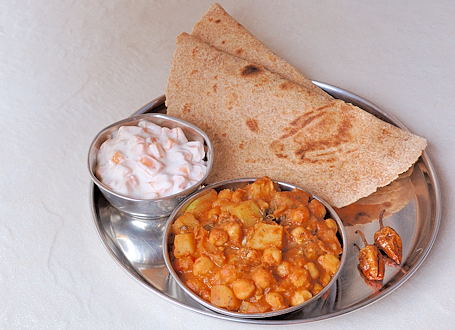
Notes:
Punjabi tinda is a small variety squash native to North India and prized for its pleasant taste.
Features: green skin and white colored flesh, firm texture, mildly sweet taste, size about an apple.
Available at local Indian grocery shops during Oct-Nov(seasonal), and also frozen and in tins.
Kasuri Methi = Sun-dried fenugreek leaves
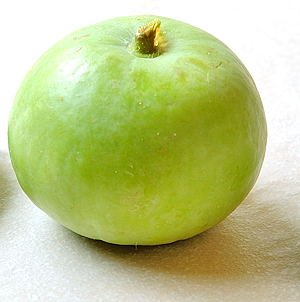
Pretty looking Punjabi Tinda is a type of winter squash, common to north India. This is a seasonal vegetable and available at Indian grocery shops – fresh, frozen and also preserved in brine, in ready to use tins. Punjabi Tinda is easy to recognize. Pleasant pale-green color and perfect round shape, they resemble green tomato or green apple in color, shape and size. The skin is tough though, needs peeling, or scrubbing. When cut open, you see firm flesh in snow-white color, and seeds will be in white or brown color depending on the maturity of the gourd. Punjabi Tinda can be steamed, stuffed, or stir-fried. It has sweet taste with a light papaya scent. Absorbs flavors well and tastes superb in strong-sauced curries and with dals.
Punjabi tinda was introduced to me by Deviji, the kind neighbor we had when we lived in Pittsburgh. She is about my mother’s age and came to Pittsburgh to visit her son. She stayed for about six months. We struck a friendship through our interest in cookery. She couldn’t get enough of my idly, dosas and I of her traditional Punjabi cooking. Together, we would prepare an elaborate meal combining both south and north Indian dishes, have a nice lunch and save the rest for dinner. She is a military wife, traveled all over India with her husband. She is like Annapoorna and Saraswathi when it comes to food and knowledge. I learned so much from her about ingredients and techniques that were new to me. There is nothing that compares to first hand learning that comes through the interaction with an experienced person. This rich experience started with just a “hallway hello”. And that was the best experience I ever gotten for a friendly hello.
The following recipe is from Deviji. Punjabi Tinda cooked with toor dal and seasoned with tomato, onion and tamarind. A very good dal!
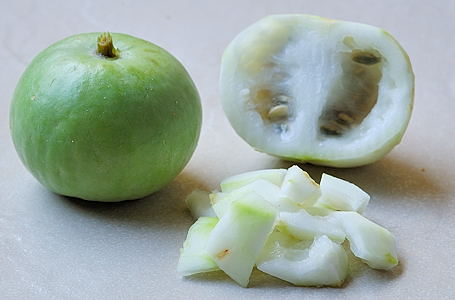
Recipe:
¾ cup toor dal
1 Punjabi tinda, peeled and cut to big chunks
Tomato and onion, one each and 6 green chillies, cut to chunks
Tamarind pulp – two teaspoons or to taste
Turmeric and Salt – to taste or quarter teaspoon each
Popu or tadka ingredients
Take toor dal and two cups of water in a pressure-cooker.
Cook to soft, and then mash the dal to smooth. Keep aside.
In a pot, heat oil and do the popu(toast cumin, mustard and curry leaves in oil).
Add Punjabi tinda, tomato, onion and chillies to toasted popu. Saute to tender.
Stir in tamarind, salt and turmeric.
Add the cooked toor dal and about one cup of water.
Simmer for about ten to fifteen minutes.
Serve or spoon into a small bowl and enjoy with rice or chapatis.
